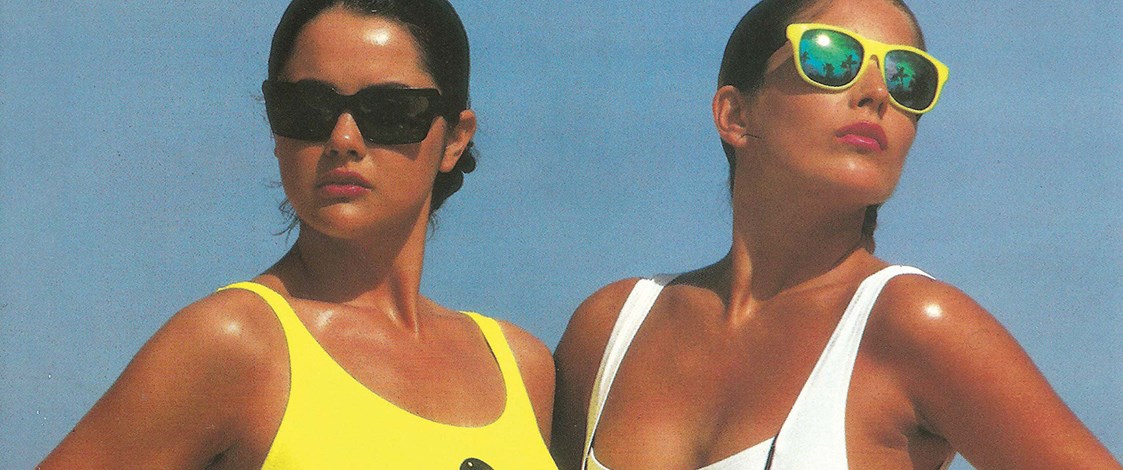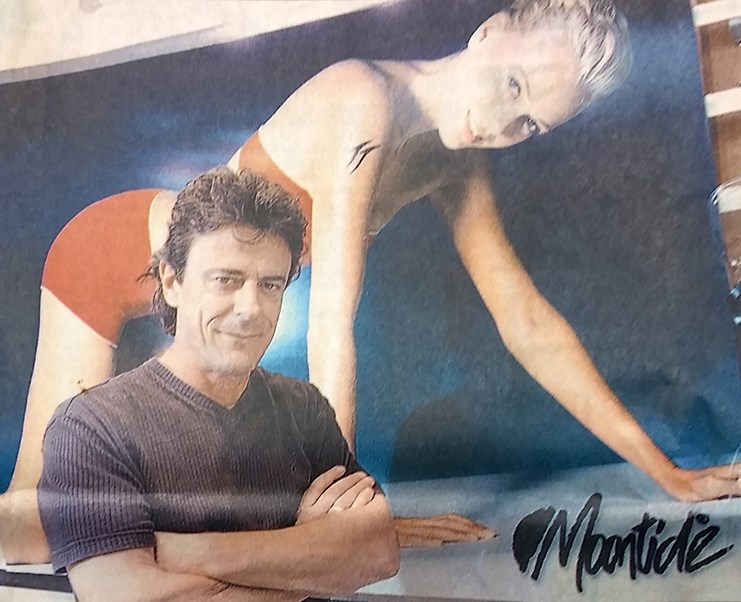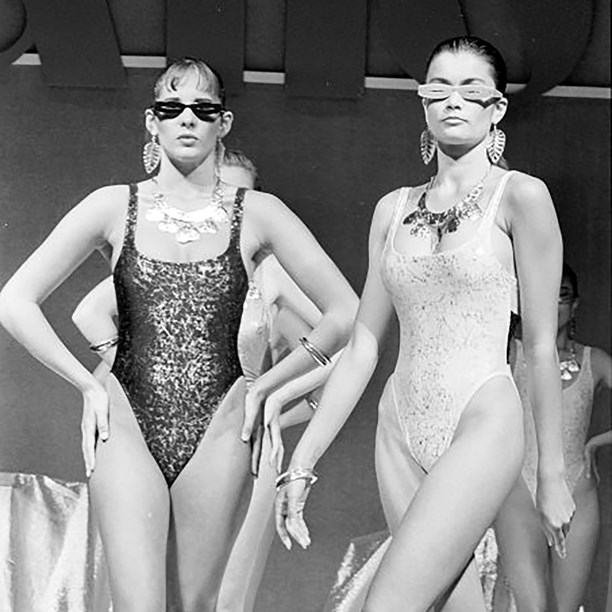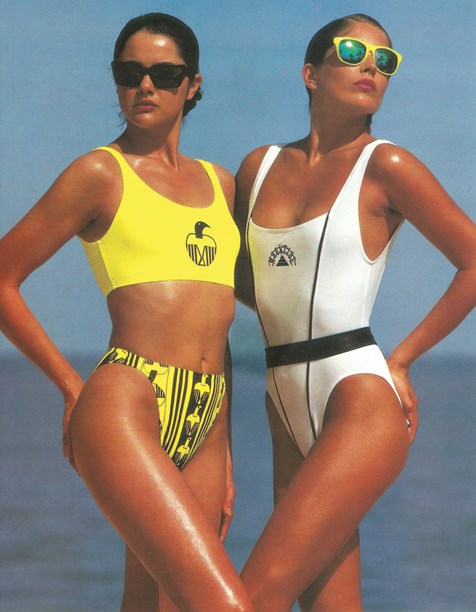Stories
Moontide
1980-

Throughout the 1980s, Moontide went head to head with Expozay in the New Zealand swimwear market. They became the most sought-after brands here and in Australia.
Moontide was established at the beginning of the decade by Tony Hart. Described by former Moontide design director Adrian Ramsay as "the Steve Jobs of swimwear", Tony lived and breathed swimwear design.
He was born in 1950 in Wellington, the youngest of five children and youngest brother to Walter Hart (founder of Hart Manufacturing). In the late 1960s, Tony trained as a manager for Woolworths, and managed the Blenheim branch for a while. Within a few years he decided to go out on his own, opening a fashion boutique in his hometown, The Booth - one of the first 'designer labels' boutiques in New Zealand.
In 1975 Tony moved to Auckland to help Walter with the Jag and Vamp labels. The brothers formed a new company, Harbro, and started supplying price-pointed garments to Woolworths and Shanton Apparel. Working with designer/pattern cutter Janice Brown, Harbro produced a swimwear range for Shanton, selling many thousands of swimsuits.
In 1980 Woolworths put out a tender for 10,000 swimsuits. Tony spent about $20,000 and many hours - supported by Hart Manufacturing - making a sample range to bid for the tender. He lost out to established label, Expozay. Left with a complete range, Tony decided to exhibit it at the New Zealand Fashion Fair in 1981. Branded 'Moontide', the label was a great success.

Tony Hart in front of a poster of model Sarah O'Hare wearing Moontide, 1991.
Tony took his label straight into the Australian market. It won $NZ150,000 of sales in the first year, but the fast growth and the complexity of dealing with Australian department stores put the company under great financial pressure. They pulled out of the Australian market and consolidated.
The label's second foray into Australia was more successful. "It was all done through sales agents," says Catriona Stewart, Moontide's marketing manager from 1987 to 1995. "We started applying that model to other markets around the world, working with New Zealand Trade and Enterprise to connect with agents and distributors and travelling a lot. Expozay were already in the States and booming, so we decided to look at the UK and Europe." They started to shoot "beautiful, international calibre" campaigns. "To compete on the world stage we had to up our image," Catriona recalls. "We set out to look as sophisticated as anything you could find in the world."

Moontide swimwear at the Canon Fashion Show, 1987. Photo by William West for The Dominion Post, courtesy of Alexander Turnbull Library, Ref: EP/1987/0193/3-F.
The British magazine Underlines named Moontide its best swimwear range in 1990 - the first of a collection of national and international accolades and awards.

Moontide swimsuits photographed for 3 Bears seasonal publication, 1989. Image © Moontide.
Before long, the ambitious Kiwi brand was being sold to many countries around the globe, including the United Kingdom, Spain, France, the Netherlands, Germany, Canada, Australia, Japan, Hong Kong, Singapore, Taiwan and the Pacific Islands.
Expozay was already well established in the market, so Moontide set out to differentiate themselves. Catriona describes the handwriting as, "very design-led, more sophisticated, avant garde … retailers loved it". The design director from 1994 to 1997, Adrian Ramsay, acknowledges the synergy between Tony and his marketing manager. "Catriona showed Tony a refined and beautiful world. She lifted the standard of his vision and brought the elegance, and the customer that came to that."
The team did things with Lycra that had never been done before. They bought stunning outerwear overseas and adapted the features into swimwear - eyelets, quilting, fagoting, boning. That outerwear influence morphed into bodywear ranges that were hugely successful. "In the 1990s everyone was wearing our bodysuits with wired sweetheart necklines," says Catriona. When the streetwear trend emerged, Moontide added the French/American streetwear label Bisou Bisou to their offering, manufacturing it under licence. Other evolutions over the years included gymwear, Moontide Kids, Vixen (female surfwear) and Quayside for older women, which was later sold to Ezibuy.
By 1995 Moontide was being manufactured offshore and sold under licence in the United Kingdom (winning a UK Best Sportswear award in 1998) and later in Hong Kong. Catriona says. "Tony was incredibly energetic and positive and filled with determination and ambition. Nothing would stop him. If he thought 'we’re going to go into Japan', we’d go into Japan. There was no reason not to give things a try. We felt we had an incredibly beautiful, world-class product, why not give it a try?"
Moontide were one of four labels - alongside Zambesi, WORLD and Wallace Rose - invited to be the first New Zealand brands to show at Australian Fashion Week in 1997. The following year they were joined in Australia by Blanchet, Karen Walker, Kate Sylvester and Workshop. Moontide’s show in 1998 featured garments printed with a Māori motif, and the runway show included the wearing of a Korowai (woven cloak). Moontide’s agreement with hapu to use the kowhaiwhai pattern, which included a royalty payment, was groundbreaking and is still quoted in academic texts to this day.

Moontide's Australian Fashion Week show in 1998 featured garments printed with a Māori motif. Image © Moontide.
Colleen - Tony's second wife and his partner of 22 years - says that he drew inspiration from everywhere. "From the international trade fairs, music videos, a woman walking down the street, a flash of colour - something would spark his brain into gear. He had piles of manila folders at home and he would go through all the international magazines every month tearing pages - that was his down time!"
The company was constantly innovating. "Women’s busts were growing, so we sized certain garments so you could buy them in a DD top as well, and we fitted every style on both a size 10 and a size 14. It opened up a whole other range of customers to us," Adrian says.
No one was making nor retailing swimwear as separates and Moontide realised the opportunity. In 2004 they evolved the separates concept with tops, bottoms, prints and accessories - the beginning of large scale bikini wardrobing and another strong sales surge.
At one stage Tony, Adrian and their team took every pattern that was current and reengineered it so it could be manufactured through a more efficient 'nest' process. They developed a ground-breaking technique where they made the Lycra do the work, not the elastic. Not only did this eliminate much of the elastic that women felt drew attention to areas they’d rather not accentuate, it was integral to Moontide’s hugely successful reversibles programme.
Reversibles starred in a foray into the United States. "Over the years Tony and I had decided on the few customers we wanted, both in Los Angeles," Colleen Hart recalls. "One of the two was Canyon Beachwear, who had 11 stores. On my fifth appointment I said to the owner, 'I can’t come back if I don’t taking an order home this time, it’s too expensive'." Colleen walked out with an order for $US130,000. Two years later the US sale were up to $US1,000,000 - all reversibles.
And that Steve Jobs reference? Adrian explains, "Tony put enormous pressure on himself and everyone around him to succeed. He dragged people around his charisma, but he cared about them. Like Steve Jobs, he’d created a bubble of creative need that he would suck everybody into and out would spit gold and sparks and flowers and f**king lightning! You would have created some amazing new style, but Tony birthed the environment that it was created in."
Tony died of cancer at home in Auckland’s St Mary’s Bay in 2009. On his gravestone is etched "Shine on, you crazy diamond." A year earlier, the Moontide intellectual property was sold to the UK licensees who continues with Moontide and a new young label Piha; branded with the New Zealand story, manufactured in China and sold in more than 40 countries. In 2017 they reintroduced 'reversibles' to their offering with resounding success.
Text by Julie Roulston.
Last published February 2018.